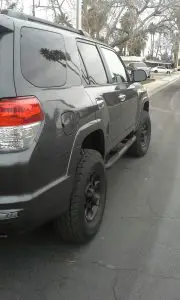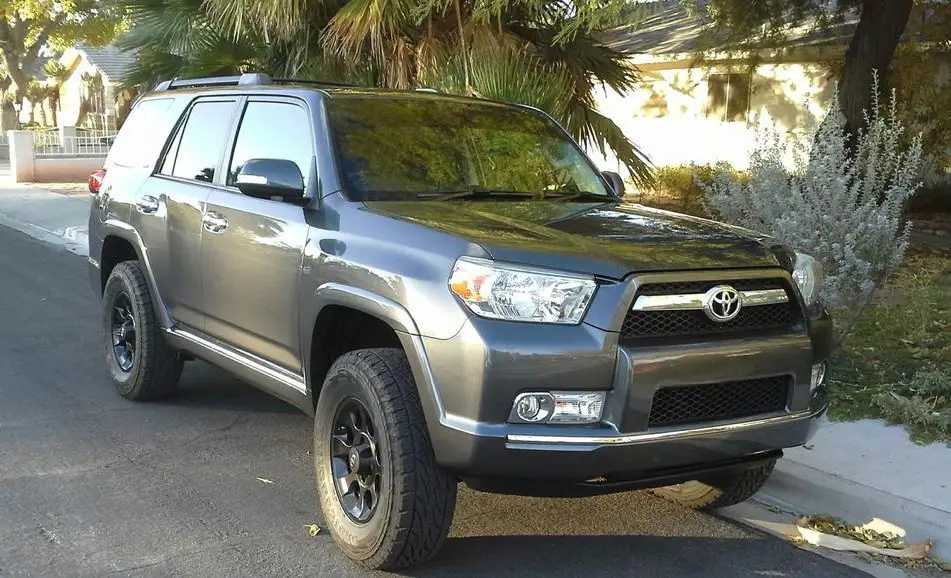Contents
1/2-inch (12mm)Moving wheels 1/2-inch outwards eliminates rubbing and clearance issues when installing aftermarket wheels. |
1-inch (25mm)A super-effective accessory to increase stability and give a noticeably aggressive stance. |
1.5-inch (40mm)By pushing out the wheels further out from the hub with 1.5-inch wheel spacers you gain in handling characteristics and get a catchy look. |
2-inch (50mm)Allow for significantly wider tires to improve road grip and traction when off-roading. |
2.5-inch (63mm) |
3-inch (75mm) |
The Benefits of Using Wheel Spacers on Toyota 4Runner
Spidertrax Wheel Spacers are one of the best options if you’re looking to widen your truck’s stance and push your wheels further outward. They are made of high-quality material by a company that puts the customer first.
Wider Wheels VS Taller Wheels
Having wider wheels means that you’ll have more contact between the tire and fender liners or body. This results in rubbing which in turn causes wear and tear and affects your vehicle’s handling. Taller wheels will cause rubbing too but to a lesser extent.
Other factors that determine your tire fitment include the model, make, suspensions, UCAs, and coils. A tire calculator can be used to determine the size of the wheel. This provides room for better judgment on the best wheel size to run and the amount of trimming required.
Why You Might Need Wheel Spacers
- To improve stance: Wheel spacers push the wheels outwards giving your 4Runner a much more menacing appearance. This is one of the most popular reasons why people install spacers. It is, however, personal preference as some people don’t like them.
- To optimize clearance: Some types of brake calipers require you to adjust the caliper clearance on your Toyota 4Runner. Others don’t. This can be achieved by installing wheel spacers.
- To correct your vehicle’s offset: When installing a leveling kit or a suspension lift, new wheel spacers may be needed. A lifted 4Runner means that you’ll have your wheels much closer to the wheel well. This causes the upper and lower control arms to face further downwards instead of outwards. The wheels and tires are brought in, causing rubbing. Spacers can help with pushing your tire and wheel away from the wheel well. This, however, depends on the application as the spacers could cause more rubbing.
- To prevent rubbing: Installing wheel spacers does not necessarily prevent rubbing. Pushing your wheels outward means that they are much closer to the fender liners. The inner liner screws should be removed and the liner pushed forward and re-screwed to prevent rubbing on the inner wheel well liner. Trimming the wheel well is also a viable option where there’s tire rubbing.
Choosing Bolt Pattern & Thickness
Where the Vehicle Uses Lug Nuts
Wheel nuts normally have studs extending from the hub. To determine the spacer thickness that you’ll need, start by placing washers on the studs. Each stud should have an equal number of washers at a time. Start by placing only a few of them (one or two). Try re-installing your wheel to see if it fits. Be cautious of the caliper/wheel clearance. Restrict from rotating the wheel to avoid damaging new parts. Add a washer each time you need extra clearance.
There needs to be enough distance where there’s a clearance problem at the break. The appropriate thickness usually ranges from 1 to 3 mm. The clearance here isn’t static. You can test it out by passing a piece of paper through the spacing. Even the slightest amount of clearance works. It will remain unchanged when the wheel is properly bolted and torqued.
As you take care of your caliper clearance, check also the potential clearance on the other side. Remember that your tires will be getting closer and closer to the fender. You need enough distance on all sides.
Once the washers installed to give the adequate clearance needed, remove the wheel and all the washers from one of the studs and measure the total width. This is the size of the spacer you need. All studs should have an equal amount of washers. If not, repeat the whole process until you attain equal spacing on all studs.
Where the Vehicle Uses Lug Bolts
Lug bolts go through threaded holes found on the hub. Here, the process is a bit hectic but workable. Insert all the bolts through the threaded holes. Add washers onto them from the other side of the wheel.
The washers can drop off from the bolts. Keep the wheel oriented vertically to prevent this. Install your wheel. Check the washer thickness. Add or subtract washers until you’re satisfied with the fitment. Measure the total width and take the measurement as the thickness of the required spacer.
Installing Wheel Spacers on Toyota 4Runner
Step 1: Jack up your truck and remove the tires.
Step 2: Loctite the existing wheel studs.
Step 3: Place your spacers on the studs.
Step 4: Take note of the direction of the nuts.
Step 5: Thread down all the nuts.
Step 6: Torque your wheel spacers to between 75 and 85 pound-feet.
Step 7: Place the wheels onto the wheel spacer studs and tighten them to the appropriate torque.
Each 4Runner is made differently. Variations arise due to differences in the model and year. Installing wheel spacers does not automatically clear bigger tires. Sometimes, it causes more rubbing.
To prevent this from happening, push back your fender liners and trim the wheel well. Repeat the process severally if need be. Sometimes, you might be forced to replace the entire front bumper with a new broader one.
Toyota 4Runner Mods with Wheel Spacers: Before & After (Pics)

Spidertrax 1.25″ spacers.
Appearance: Sticking the Toyota 4Runner wheels out to expand the uplift and more impressive design.
Clearance: Many factory Toyota 4Runner wheels do not have enough of clearance to go along with big brake kits.
Correction: The offset of the Toyota 4Runner wheel assembly appears to be too high, leading to the wheels sitting too far inside. This might urge the tire to rub on the inside Toyota 4Runner wheel well, or other elements. Wheel spacers fine-tunes the offset challenge.
Handling: by arranging your Toyota 4Runner wheels further afield, this straight-forward change can elaborate the Toyota 4Runner car with more horizontal firmness and improved cornering.
